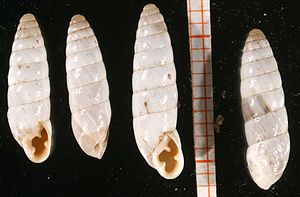Chondrus (animal species)
| Chondrus | ||||||||||||
|---|---|---|---|---|---|---|---|---|---|---|---|---|

|
||||||||||||
| Systematics | ||||||||||||
|
||||||||||||
| Scientific name | ||||||||||||
| Chondrus | ||||||||||||
| Cuvier , 1816 |
Chondrus is a genus of the family of wolverines (Enidae) from the suborder of land snails (Stylommatophora).
features
The left- or right-handed, cylindrical to tower-shaped cases are 10 to 27 mm high and 3 to 7 mm wide. The nine to twelve, slowly increasing turns are flattened on the periphery and only separated from each other by a shallow seam. The mouth is rounded triangular and pointed at the upper end, or also rounded. It is comparatively small, but the shape and size can also vary within a species. The muzzle plane is slightly inclined to the axis of the housing. The relatively firm mouth edge is slightly bent outwards and moderately to significantly thickened. The points of attachment of the mouth to the previous turn are not approximated to one another and are connected to one another by a pronounced white layer. Three to four teeth or lamellae protrude into the mouth, a strong palatal tooth, a parietal fold deep in the mouth, a horizontal columellar fold, and occasionally a very small cusp at the base of the spindle. The navel is only a short gap.
The skin is usually chalk white, often with more or less numerous dark stripes. The apex is usually dark as well. The surface of the embryonic convolutions are smooth, the postembryonic convolutions show a sculpture of fine, irregular fold-like growth strips and fine spiral elements. Radial and spiral elements can form a reticular pattern.
In the male tract of the reproductive system, the spermatic duct (vas deferens) enters the very long and thickened epiphallus apically . The flagellum at the entrance to the vas deferens is only rudimentary. After about a third of the epiphallus length, a short conical caecum has developed. The diameter of the epiphallus now decreases to about half. The short, strongly thickened penis takes up only about a third of the epiphallus length; a penile caecum is missing. The very long penile appendix branches off shortly before the penis joins the atrium. This consists of a long, thickened lower part, a spherical-thickened part, a short, moderately thick middle part, a very long and very thin middle part and a worm-shaped thickened end part. The retractor muscle divides into two strands, one of which attaches to the thickened lower part of the penile appendix (close to the spherical-thickened part), the other to the penis close to the transition to the epiphallus. In the female tract, the free fallopian tube is about twice as long as the vagina. The spermathec is moderately long with an elongated seminal vesicle and a very long worm-shaped diverticulum .
Geographical distribution
The few species of the genus occur on the Balkan Peninsula, in Greece and in Asia Minor.
Taxonomy
The taxon Chondrus was established by Georges Cuvier in 1816 . In the description of Chondrus two footnotes appear in which the species originally assigned to Chondrus are listed: (1) Bulimus zebra Olivier, 1801, Pupa tridens Draparnaud, 1801 and Pupa variabilis Draparnaud, 1801, and (2) Bulimus avenaceus Brugière, 1792 ( Pupa avena ), Pupa secale Draparnaud, 1801 Pupa frumentum Draparnaud, 1801 Bulimus similis Bruguière, 1792 Pupa cinerea Draparnaud, 1801 Pupa polyodon Draparnaud, 1801 and helix quadridens Bruguière, 1792. type species is Bulimus zebra Olivier 1801 by determining by John Edward Gray (1847: p. 175). Bulimus zebra Olivier, 1801 was preoccupied by Bulimus zebra Brugière, 1792 and was initially replaced by zebriola by André Étienne d'Audebert de Férussac in 1821 , and in the same work was corrected to zebrula . Chondrus is currently generally recognized as an independent genus (Fauna Europaea, Welter Schultes, Gümüş & Neubert). There is also a genus Chondrus in the vegetable kingdom .
- Genus Chondrus Cuvier, 1816
- Chondrus lycaonicus (Sturany, 1904)
- Chondrus tournefortianus (Férussac, 1821)
- Chondrus zebrula (Férussac, 1821)
supporting documents
literature
- Burçin Aşkım Gümüş, Eike Neubert: New taxa of terrestrial molluscs from Turkey (Gastropoda, Pristilomatidae, Enidae, Hygromiidae, Helicidae). ZooKeys, 171: 17-37, 2012 doi : 10.3897 / zookeys.171.2273
- Anatolij A. Schileyko: Treatise on Recent Terrestrial Pulmonate Molluscs. Part 2. Gastrocoptidae, Hypselostomatidae, Vertiginidae, Truncatellinidae, Pachnodidae, Enidae, Sagdidae. Ruthenica, Supplement 2 (2): 129-261, Moscow 1998 ISSN 0136-0027
- Francisco W. Welter-Schultes: European non-marine molluscs, a guide for species identification = identification book for European land and freshwater mollusks. A1-A3 p., 679 p., Q1-Q78 p., Planet Poster Ed., Göttingen 2012, ISBN 3-933922-75-5 , ISBN 978-3-933922-75-5 (p. 132)
Individual evidence
- ↑ Georges Cuvier: Le règne animal distribué d'après son organization, pour servir de base à l'histoire naturelle des animaux et d'introduction à l'anatomie comparée. Avec figures, dessinées d'après nature. Tome II, contenant les reptiles, les poissons, les mollusques et les annélides. I-XVIII, 1-532, Paris, Deterville 1816 ("1817") online at www.biodiversitylibrary.org . (P. 408)
- ^ A b c André Étienne d'Audebert de Férussac: Tableaux systématiques des animaux mollusques classés en familles naturelles, dans lesquels on a établi la concordance de tous les systèmes; suivis d'un prodrome général pour tous les mollusques terrestres ou fluviatiles, vivants ou fossiles. S. I-XKVII, 1-27, 1-110, Paris & London, Bertrand & Sowerby Online at www.biodiversitylibrary.org (p. 58).
- ↑ Fauna Europaea
- ^ Rudolf Sturany : Brief diagnoses of new gastropods. Gazette of the Imperial Academy of Sciences, mathematical and natural science class, 41 (10): 115-119, Vienna 1904 Online at www.biodiversitylibrary.org (p. 118)
On-line
annotation
- ↑ According to Gray's explanation on p. 130, the species named after a genus is the type species.